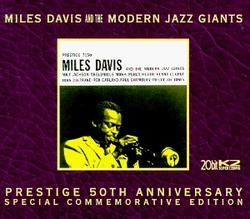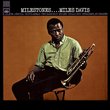| All Artists: Miles Davis Title: Miles Davis & the Modern Jazz Giants (20 Bit Mastering) Members Wishing: 0 Total Copies: 0 Label: Prestige Release Date: 10/19/1999 Album Type: Original recording remastered Genres: Jazz, Pop Style: Bebop Number of Discs: 1 SwapaCD Credits: 1 UPC: 025218480826 |
Search - Miles Davis :: Miles Davis & the Modern Jazz Giants (20 Bit Mastering)
 | Miles Davis Miles Davis & the Modern Jazz Giants (20 Bit Mastering) Genres: Jazz, Pop
Most of the music on this CD comes from an unusual session held on Christmas Eve of 1954 at Rudy Van Gelder's Hackensack, New Jersey, studio. Gathered there were five giants of the bop movement, most linked by the highest ... more » |
Larger Image |
CD DetailsSynopsis
Amazon.com Most of the music on this CD comes from an unusual session held on Christmas Eve of 1954 at Rudy Van Gelder's Hackensack, New Jersey, studio. Gathered there were five giants of the bop movement, most linked by the highest musical sympathy. Vibraphonist Milt Jackson, drummer Kenny Clarke, and bassist Percy Heath were all members of the Modern Jazz Quartet, having worked extensively with the session's pianist, Thelonious Monk, while Clarke and Heath had worked throughout the year as Miles Davis's rhythm section. The only incompatibility was between Davis and Monk, and it shows in what isn't here: though they shared an almost sculptural sense of musical structure, Davis hated Monk's comping and asked him not to play during his solos. The hurt feelings never show in the music, though, with two profound and distinct takes of "The Man I Love," a lively version of Monk's "Bemsha Swing," and Davis's first exploration of scale composition, "Swing Spring," all linked by focused musical invention and inspired swing. Whatever he thought of Monk's playing, Davis had the highest regard for his compositions. It shows here in the arrangement of "'Round Midnight" recorded at Davis's final Prestige session in October of 1956, with its thoughtful contrast between Davis's pensive, muted theme statement and John Coltrane's aggressive tenor solo. --Stuart Broomer Similar CDs
|
CD ReviewsAn early masterpiece G B | Connecticut | 09/26/2001 (5 out of 5 stars) "The official line is that Miles Davis's "comeback" from heroin addiction and relative obscurity happened at the 1955 Newport Jazz Festival. But the truth is that Davis had been recording actively in the studio during all of 1954, and that the results ranged from excellent to spectacular. The bulk of the music he recorded that year was for the Prestige label; it was packaged primarily on three LPs: "Walkin'", "Bags' Groove", and "Miles Davis and the Modern Jazz Giants". Though all three are essential for the Miles Davis fan, this one is probably the best. For one, four of the tracks come from Davis's only session with the pianist Thelonious Monk. (The other two tracks from that session are on "Bags' Groove".) Monk and Davis didn't get along -- Davis hated Monk's angular comping, and demanded that the pianist lay out during the trumpet solos. But Monk rose to the challenge, providing some inspired solos. For two, the other three musicians (all members of the Modern Jazz Quartet, hence the name of the LP) play really well. Vibraphonist Milt Jackson rarely played better, while few rhythm sections swung harder than Percy Heath and Kenny Clarke. For three, Miles Davis plays some of the most beautiful trumpet solos of his career; the ballad playing on both takes of "The Man I Love" is absolutely gorgeous, while on the more up tempo numbers his clear tone rings out like a bell. For four, the performances are incredible -- "Bemsha Swing", "Swing Spring", and the two takes of "The Man I Love" are all desert island material. As an added bonus, this CD includes a take of "Round 'Midnight" recorded by the Quintet with Coltrane and Garland two years later. This version is not quite as memorable as the one recorded for Columbia but is excellent nonetheless. There is no excuse for not owning this wonderful album, especially in the crystal clear 20 bit remastered version -- it is one of the best of Miles Davis's career." Was there EVER a more appropriate title? Jack Dempsey | South Miami Beach, Florida | 03/04/2005 (5 out of 5 stars) "Jazz Giants indeed. You got Miles. You got Milt. You got Monk. That's just the M's folks. Then you got Trane. Then Red, then Heath, then Chambers, then Clarke, then Philly. My God it simply doesn't get much better than that. As most people have pointed out, this was recorded right at the time of the equally incredible "BAGS GROOVE" lp. As a side, if you don't have that, get it. Period. Also as is quite well-known, there were some hurt-feelings between Miles and Monk that happened in this session. Christmas Eve, 1954 session...on the Christmas Eve date, Miles asked Monk to lay out and not comp behind his solos, leading to a priceless moment on the second take of Gershwin's "The Man I Love." A muted Miles begins at a dirge-like tempo, as Jackson and Monk toll away; a tempo change keys a swinging Milt solo--transforming the ballad into a hard blues--and Monk kind of mindlessly and by the numbers, almost pronouncing the...man...I...love in hilarious rhythmic paraphrases and long, long rests--disappearing completely just before the bridge as Clarke and Heath burn along. Finally Miles paraphrases the theme from "Four" by way of saying "helloooooo" and the pianist comes back with stomping blues chords. As they say, priceless. But, the animosity never fully healed and was never fully put behind the two. This is a beautiful, beautiful recording and it captures a time, moment and energy that can never again be recaptured. They simply don't come like this anymore. Get this now and cherish it forever. And, get the K2-20 bit remastered version, without a doubt. It is vastly superior to the regular version. Likewise, if you're considering "BAGS GROOVE" and don't already have it (shame on you for not having it), I would recommend the JVCXR (extended resolution) version. Pricier, but worth it." Phenomenal set R. J. Marsella | California | 03/08/2004 (5 out of 5 stars) "Each track on this set is a masterpiece in it's own way. The one cut featuring the personel from Miles' first quintet is a standout for me. Round Midnight never sounded better than it does here. Coltrane's solo just soars and contrasts beautifully with Miles' softer approach. THe other tracks feature Milt Jackson and Monk and they play off of each other beautifully.. The highlight is Miles indescribably expressive trumpet playing here. The seed are being sown for his future masterpiece recordings and with these fine musicians backing him up the sound that is achieved is stunning. Percy Heath's bass lines are so crisp and the remastering really allows the bass lines to jump out of the speakers. This along with the remastered version of Bags Groove with the same lineup are highly recommended. Sound quality is A ++."
|

 Track Listings (5) - Disc #1
Track Listings (5) - Disc #1